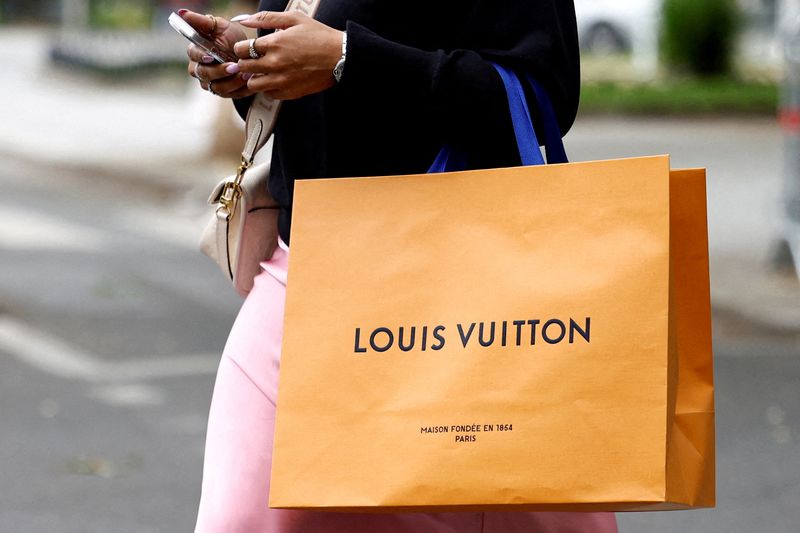By Mimosa Spencer and Sami Marshak
PARIS/NEW YORK (Reuters) -Luxury goods companies were spared their worst case scenario in Sunday’s EU-U.S. trade deal but they face a delicate balancing act as already weak consumer demand tests their ability to raise prices further.
Big labels like Chanel and LVMH’s Louis Vuitton and Dior have relied on dramatic price increases in recent years to drive a chunk of their profit growth.
Jacques Roizen, managing director, China, at Digital Luxury Group, said the deal struck by U.S. President Donald Trump and European Commission President Ursula von der Leyen on Sunday, imposing a 15% tariff on EU goods, brings much needed certainty to luxury’s key U.S. market.
Yet, “brands are treading carefully with further price hikes to avoid alienating younger and occasional shoppers,” he said.
Although baseline duties are below a hefty 30% levy that Trump had threatened just a couple of weeks ago, they are a far cry from the zero-for-zero tariff deal Brussels was hoping to clinch.
Fresh tariffs also come as the luxury goods industry is counting on the U.S. as former growth engine China sputters and sales globally are in decline.
“Tariffs are definitely going to affect my buying behaviour, depending on the rate of the tariff. I would think twice before I just pick things up,” said Abida Taher, a 53-year-old physician who was out shopping at Saks Fifth Avenue in New York City last week and likes Valentino among other Italian and French brands.
Bernard Arnault, chairman and CEO of French luxury giant LVMH, embarked on an intense lobbying campaign with EU leaders to ease tensions with the Trump administration and last week announced plans for a new Louis Vuitton factory in Texas.
Such a move, however, would be too complicated and costly for most European brands – involving the transfer of local skills that take years to build up, industry experts caution.
Some high end labels say they will be able to draw on pricing power to offset the cost of tariffs, but analysts and industry practitioners warn some players have limited wiggle room after a series of outsized price tag hikes.
Big luxury companies profited from a rebound of consumer demand after the pandemic, hiking prices by 33% on average between 2019 and 2023, according to RBC estimates.
The price tag of Chanel’s classic quilted flap bag more than tripled between 2015 and 2024, while the Lady Dior bag and Louis Vuitton Keepall travel bag more than doubled, according to UBS analysts.
LUXURY DISCONNECT
Half of the luxury industry’s sales growth came from price hikes in the four years from 2019, compared to a third between 2016 and 2023, UBS analysts said.
Yet the sector lost 50 million customers last year, according to consultancy Bain, as economic pressures and price fatigue dampened appetite for designer clothing and handbags.
Brands that got the pricing balance wrong are the ones struggling more today, said Flavio Cereda, who manages GAM’s Luxury Brands investment strategy.
“The significant deceleration in momentum, uneven as it was, is a natural consequence of a period of excess,” said Cereda.
Hermes, which notably held back on large price increases during the post pandemic boom, has outpaced rivals and analysts forecast a 10% rise in second quarter sales when it reports on Wednesday.
UBS estimates that a 15% tariff on exports to the United States will require luxury brands on average to raise prices by around 2% in the United States, or around 1% globally if they want to avoid widening regional price gaps – or face an impact of around 3% on earnings before interest and tax.
Such hikes may prove challenging while the latest round of luxury players’ earnings shows little sign of a rebound.
LVMH’s second quarter sales missed expectations, weighed down by weakening sales at flagship brands Louis Vuitton and Dior, while outerwear specialist Moncler’s sales contracted by 1% and Kering-owned Gucci is expected to continue to struggle.
Caroline Reyl, head of premium brands at Pictet Asset Management, said there has been a “disconnect” between the prices of certain luxury items and their perceived quality and creativity in the past four years.
Precious Buckner, a 37-year old clinical therapist from North Carolina, was looking at a Chanel classic flap bag at Saks Fifth Avenue in Manhattan last week but said if it goes up in price because of tariffs it would no longer be worth it.
“I’m going to these stores to see the size, the fit, how I like it, so I can get it on resale,” Buckner said, noting she would be willing to pay $8,000 for a bag on a resale platform like The RealReal or Fashionphile rather than pay $12,000 in a department store.
Bain forecasts worldwide luxury goods sales will fall by between 2% and 5% in 2025 after a 1% decline last year, the biggest contraction in 15 years excluding COVID.
To counter the downtrend, the industry has embarked on a recruitment drive, with new designers at Chanel, Gucci, LVMH labels Dior, Celine, Givenchy and Loewe, and Versace.
Yet, renewing styles to find a better alignment between prices and product value will take time.
“You can’t snap your fingers and do it in a couple of weeks,” said Reyl.
(Reporting by Mimosa Spencer and Sami Marshak; Editing by Lisa Jucca and Susan Fenton)

